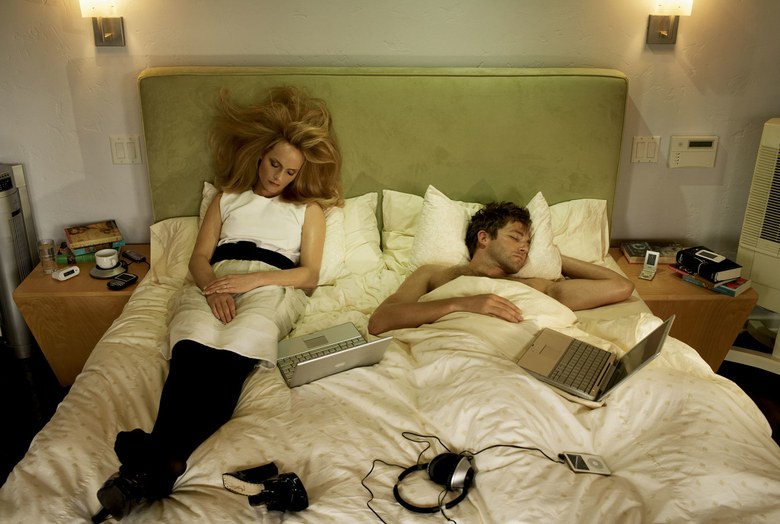In the frenzied never-ending search for more sleep, you can’t say people aren’t getting creative. There are beanie-like sleep caps that claim to bring down brain activity, magnetized pillows to align the biological clock, and body creams that “rub out” insomnia, such as the pale purple Sleepy Lotion by Lush, which boasts a cult-like following among the restless. Even podcasts like Sleep With Me or Sleep Whispers have been specially designed to bore and in turn, help clock in more nighttime hours. And let’s not forget about creative pill cocktail-ing: “It’s not uncommon for people to tell me they’re taking an Ambien, two Tylenol PM, and a glass of wine and still only get three and a half hours of sleep at night,” says Michael Breus, Ph.D., a fellow of the American Academy of Sleep Medicine. Desperate? That might be an understatement. But there’s exciting news for the bleary-eyed: A non-addictive, healthy bedtime fix already exists. And it’s really effective.
The official title—Cognitive Behavioral Therapy for Insomnia (CBT-I)—carries the appeal of raw broccoli to an 8-year-old stuck at dinner, but it’s been shown to help 70 to 80 percent of people with the disorder, which is diagnosed after enduring broken, irregular or inadequate sleeping habits at least three times a week. (After three months, it’s labeled chronic insomnia—a struggle for a staggering ten percent of the population.) And for those with milder or new sleep problems who can’t seem to benefit from white noise, a chilled room or less later-in-the-day caffeine fixes, CBT-I works beautifully, says Michael Grandner, Ph.D., Director of the Sleep and Health Research Program at the University of Arizona.
And yet, even though, according to the American College of Physicians the treatment should be the first line of defense against sleep issues—long before Ambien scripts are filled or even benign supplements such as melatonin or valerian are mentioned—few of the sleepless ever hear the name. “The majority of people are being treated badly by their general practitioner,” says Grandner. “There’s little evidence that pills work, but the science behind the effectiveness of CBT-I is crystal clear.” What’s even better is that in addition to minimizing other issues like anxiety and depression, studies show online CBT-I, through mental apps like SHUTi or Sleepio, which both tailor weeks-long regimens based on daily updates by the user, can be just as effective for treating insomnia as seeing a therapist face-to-face. There’s just one catch: CBT-I can be exhausting, at least at first. Here’s how it works.
Go to bed later
Yes, really. Sleep restriction therapy—a natural way to build up your appetite for rest—is a core pillar of CBT-I. If you’re spending eight hours in bed, but you’re only sleeping for six of them, the new rule is that you spend two hours less under the sheets. “When you spend time in bed thinking, worrying, reading, working, or watching TV, the link between bed and sleep becomes weak,” says Grandner. “[CBT-I] retrains the brain [to associate] the bed as a place to snooze.” Once you’re regularly clocking six hours, start to add 20 to 30 minutes on the front end of bedtime—remember, your wakeup time should always remain the same, even on the weekends—until you’ve reached a solid seven to nine hours a night. It’s a cutthroat process, but Breus says most of his patients start to get more sleep after seven to 10 days, and after six to eight sessions, most are done with CBT-I altogether.
Don’t just lie there
Part of conditioning yourself to snooze when your head hits the pillow means getting out of bed after 20 or 30 minutes have passed and you’re still awake—even if it’s 4 A.M. Head into the next room, or to a different corner of your bedroom, and do something else, keeping in mind two rules: “The activity can’t be too bright, and it can’t be mentally engaging,” says Grandner, who points out that glowing light from a computer or television screen suppresses melatonin, making it harder to fall back asleep. After 40 minutes, head back to bed, and repeat the process if you’re still not nodding off.
Think happy thoughts
Laughable advice, considering not sleeping well, or at all, is wildly stressful, but paranoia fans insomnia-inducing flames. “Part of CBT-I is flipping or debunking beliefs and attitudes about sleep, many of which are myths,” says Breus. “[Act like] a scientist and look for evidence.” For example, if you’re terrified that missing out on eight hours every night will take years off your life, the first move is to prove it. And then, after failing to do so—”you can get by on less,” says Breus—give your brain a new thought to mull over, like “I know I can sleep just six and a half hours without seriously harming my health.” And of course, relaxation practices, like mediation, progressive muscle relaxation and deep breathing is a great way to get to a happier place—in your mind, body and bed.












